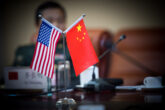August 13, 2020
China’s View of the United States’ Expanded Use of Export Controls
The United States’ recent expansion of its use of export controls to achieve foreign policy and national security goals largely has targeted Chinese entities. China resolutely has opposed U.S. use of export controls, describing them as “a disruption of market principles and fair competition” that “disregards basic rules of international trade, and is a serious threat to the security of the global industrial supply chain.” The multiple statements that China’s Ministry of Commerce (MOFCOM) has put out—in response to the United States changing the foreign direct product rule, expanding the definition of military end-use and end user, and adding Chinese entities onto the Entity List for human rights abuses in Xinjiang—are an indication that China is taking this threat seriously.
After the U.S. Department of Commerce added 33 more Chinese entities onto the Entity List in May 2020, MOFCOM stated that China would “take all necessary measures to resolutely safeguard the legitimate rights and interest of Chinese enterprises.” China’s response to the United States hasn’t been just rhetorical, it also has responded economically and diplomatically.
After the U.S. Commerce Department listed Huawei and its 68 subsidiaries on the Entity List, the Chinese Ministry of Commerce retaliated by announcing its creation of an “unreliable entities list,” with state media threatening to place U.S. companies like FedEx on the list. While China has yet to define its precise plan for use of the unreliable entities list, China’s intent behind its creation is to mimic the U.S. Department of Commerce’s Entity List.
China’s response to the United States hasn’t been just rhetorical, it also has responded economically and diplomatically.
In his annual report on the work of the government, Chinese premier Li Keqiang also stated Beijing’s intention to “boost [domestic] capacity to support technological innovation.” This statement is just an official nod toward what is already happening—increased domestic support to increase China’s technological edge. Wherever and whenever possible, Chinese companies also have begun to “design out” foreign inputs. Huawei has made significant process in shifting its dependence on U.S.-based companies such as Qorvo and Broadcom to its own Chinese subsidiary HiSilicon. These actions are further supported by government policies like the mandate to remove all foreign computer equipment and software from Chinese government agencies within three years.
The expanded U.S. use of export controls has been both to safeguard the U.S. technological edge, and also to change China’s behavior. These efforts have been ineffective, however, and have caused China to retaliate even outside the export control domain. For example, China launched a propaganda campaign to try to counter narratives of Uyghur oppression following the October 2019 Department of Commerce addition of 28 Chinese entities to the Entity List and additional nine Chinese entities in May for human rights abuses in Xinjiang.
The expanded U.S. use of export controls has been both to safeguard the U.S. technological edge, and also to change China’s behavior. These efforts have been ineffective.
As the United States continues to use export controls to restrict products that can be exported to China, China only will respond by strengthening its self-sufficiency in critical technologies and safeguarding its core national interests.
About the Author
Ashley Feng is a former Research Associate with the Energy, Economics, and Security Program at the Center for a New American Security (CNAS).
Learn More
CNAS has asked a group of experts and policymakers to offer their perspectives on the policy goals that U.S. export controls should serve, and how and under what circumstances U.S. export controls can effectively achieve those policy goals.

Export Controls Are a Defining Instrument of U.S. National Security
A group of experts and policymakers offers their perspectives on the policy goals that U.S. export controls should serve....
Read MoreMore from CNAS
-
Principles and Policy Options for Designing Better Investment Barriers
This testimony focuses on options for designing an effective program to address the national security risks that can arise from certain U.S. investments in countries of concer...
By Emily Kilcrease
-
U.S. Economic Security Strategy, Authorities, and Bureaucratic Capacity
Watch:...
By Emily Kilcrease
-
Comments on Provisions Pertaining to U.S. Investments in Certain National Security Technologies and Products in Countries of Concern
Submitted by: Sarah Bauerle Danzman (Associate Professor, Indiana University Bloomington; Senior Fellow, Atlantic Council), Tim Fist (Fellow, Technology and National Security ...
By Emily Kilcrease, Tim Fist, Sarah Bauerle Danzman, Ngor Luong & Emily Weinstein
-
Sharper: Economic Statecraft
As competition between the United States and China escalates, and the war in Ukraine continues, countries have embraced new forms of economic statecraft to accomplish key fore...
By Anna Pederson & Charles Horn




